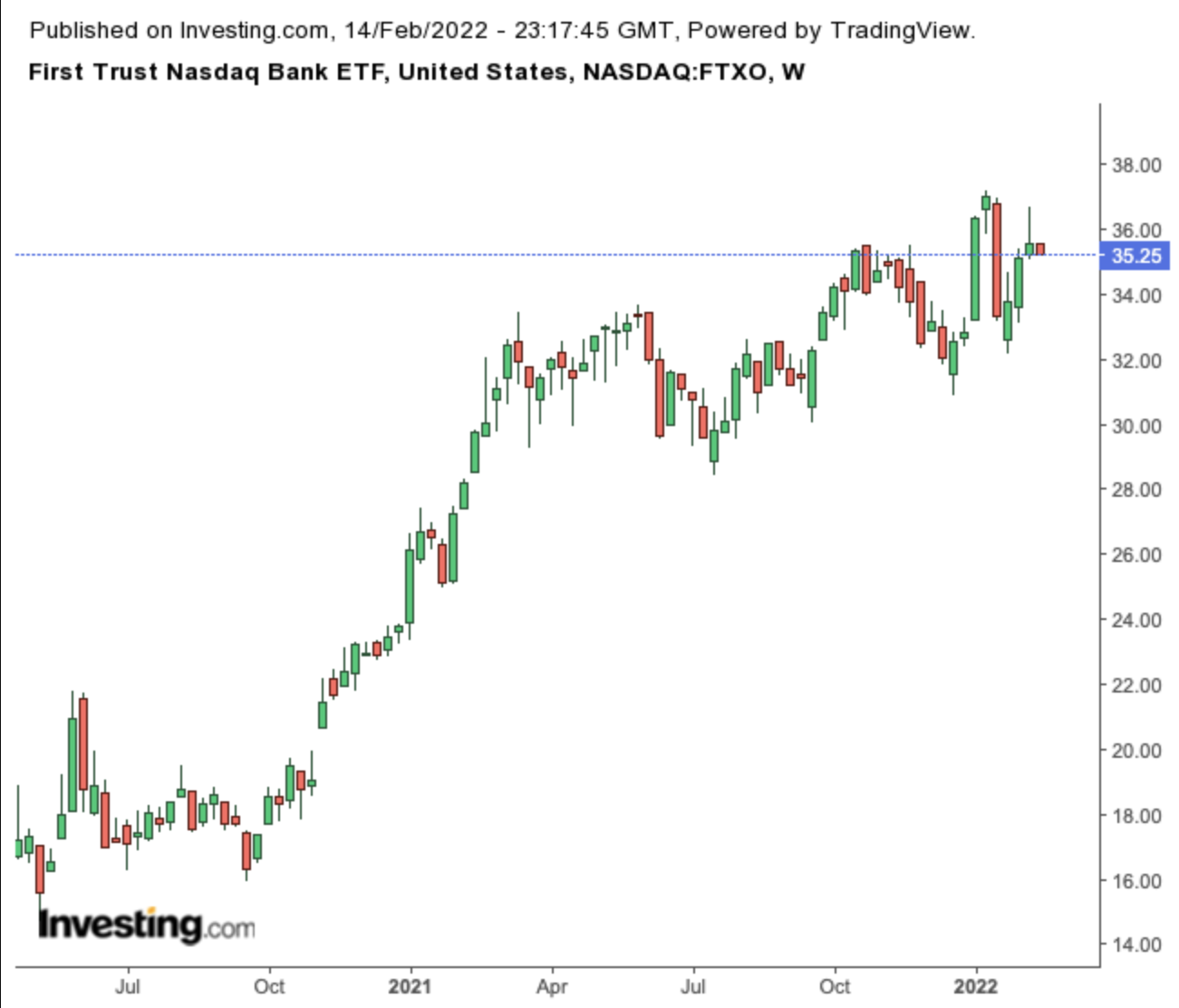Wall Street is debating whether the Federal Reserve might announce an emergency interest rate hike soon. Recent data released by the Labor Department shows inflation at 7.5%, the highest level in 40 years. As a result, St. Louis Federal Reserve Bank President James Bullard has been vocal about his hawkish views, unnerving investors.
Meanwhile, global political tensions have also added to the uncertainty facing markets. The S&P 500 and NASDAQ 100 indices are down 8.1% and 13.4% respectively for the year. Thus, a large number of equities, especially growth shares, have been under pressure.
Yet bank and financial stocks, which were among the first to report earnings in January, have shown a better performance so far in 2022. For instance, the Dow Jones U.S. Banks Index is up 5.5% year-to-date (YTD). On the other hand, the Dow Jones U.S. Financials Index lost 1.1%.
Today’s article introduces two exchange-traded funds (ETFs) for investors looking for stable financial names amidst the red-hot inflation data. Since most banks are dividend payers, passive income seekers tend to hold on to them even when markets go south. These names could also benefit from moves by the Fed as higher interest rates typically lead to improved profit margins for financial shares.
We also covered three additional financial funds recently, (here and here) that could appeal to buy-and-hold investors going forward. Today’s ETFs add to that discussion.
1. Fidelity MSCI Financials Index ETF
- Current Price: $56.23
- 52-week range: $45.65-$59.39
- Dividend yield: 1.74%
- Expense ratio: 0.08% per year
The Fidelity MSCI Financials Index ETF (NYSE:FNCL) gives access to a wide range of US financial shares. The fund was first listed in October 2013.

FNCL, which has 394 holdings, tracks MSCI USA IMI Financials Index. The top 10 holdings account for about 40% of net assets of $1.9 billion.
Banks have the highest slice with 37.87%. Next come names from Capital Markets (26.73%), Insurance (17.94%), Diversified Financial Services (8.70%), Consumer Finance (5.76%), and Thrifts & Mortgage Finance (1.04%).
Leading holdings on the roster include JPMorgan Chase (NYSE:JPM), Berkshire Hathaway (NYSE:BRKa), Bank of America (NYSE:BAC), Wells Fargo (NYSE:WFC), Morgan Stanley (NYSE:MS), and Citigroup (NYSE:C).
In the past 12 months, FNCL is up 21.9%. It hit an all-time high (ATH) in early January. But since that record high, the ETF has lost 4.6% as many names in the fund have come under pressure, especially post-earnings.
However, FNCL is still up 1.1% in 2022. Trailing P/E and P/B ratios are 11.42x and 1.63x. Interested readers, who expect the earnings of these leading financials to stay mostly sustainable in the months ahead, could consider investing now.
2. First Trust NASDAQ Bank ETF
- Current Price: $35.25
- 52-week range: $28.43-$37.20
- Dividend yield: 1.53%
- Expense ratio: 0.60% per year
The First Trust NASDAQ Bank ETF (NASDAQ:FTXO) tracks the returns of the NASDAQ US Smart Banks Index. When selecting shares, fund managers pay attention to three main factors, including “Volatility,” or the trailing 12-month price moves; “Value,” as indicated by cash flow to price; and “Growth,” or the quarterly average price appreciation over the past year.

FTXO currently has 28 holdings, where the top 10 comprise over 60% of net assets of $373.5 million. The fund started trading in September 2016.
Popular (NASDAQ:BPOP), which has operations in Puerto Rico, the US, and the Caribbean; Providence, Rhode Island-based Citizens Financial (NYSE:CFG), Regions Financial (NYSE:RF), another regional bank with headquarters in Alabama; Citigroup; JPMorgan Chase and Wells Fargo are among the leading names in the portfolio.
In the past 12 months, FTXO returned 21.2%, and like FNCL, hit a record high in the early part of January. So far in the year, it is up 7.1%.
P/E and P/B ratios stand at 9.83x and 1.32x. Put another way: despite significant returns in the past year, the valuation is not at frothy levels.
Investors who would like to have exposure to smaller banks should research this fund further. We believe many of these banks could increase their assets in future quarters.
